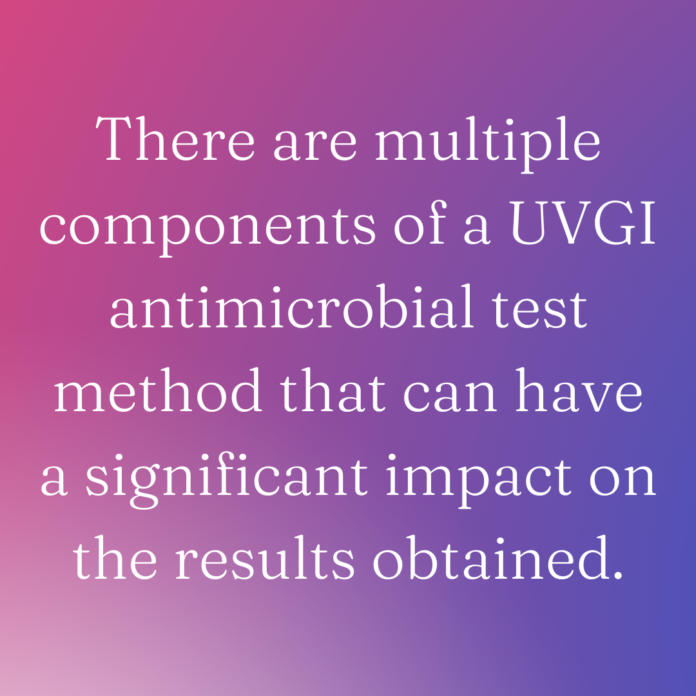By Matthew Hardwick, Ph.D., ResInnova Laboratories, and Josh Erickson, Stratix Labs
Ultraviolet germicidal irradiation (UVGI) emitters have been used as surface decontaminators, largely in the healthcare space, for more than 20 years. The number of UVGI emitters on the market has risen steadily for the last 10 or so years. These devices range from whole-room decontaminators and large cabinets able to handle wheelchairs and patient beds to small cabinets used for decontaminating smaller devices, such as mobile phones and tablets. Even handheld devices have entered the marketplace.¹ The coronavirus pandemic led to a rapid increase in the rate of new UVGI-emitting devices entering the market. Many of these devices made significant antimicrobial claims. How trustworthy are these claims? Were the tests performed in a third-party independent laboratory? How does the consumer compare one device to another?
The first question is extremely difficult for the typical consumer to answer. There are very few internationally recognized standards governing the testing of UVGI devices on surfaces. Therefore, third-party independent laboratories are forced to develop their own methods. Optimally, a laboratory will develop UVGI test methods from a combination of peer-reviewed scientific articles and one or more of the standard guidance documents available from a standards organization such as ASTM International. The second question only can be answered on a case-by-case basis. Some manufacturers/retailers are able to provide test reports from third-party independent laboratories, while others make generic “antimicrobial” claims and may include a graph, but do not provide test reports. During the height of the pandemic, a great many devices marketed as UVGI emitters on social media would make claims of “greater than 99.9% microbial kill” but would offer no more information. Thankfully, this practice has dropped off dramatically. With regard to comparing one device to another, the consumer has to rely upon peer-reviewed comparison studies, of which there are very few, and each of which only compares a few devices to one another.
If these answers feel unsatisfactory, that is because they are – and not just to consumers, but to manufacturers and third-party laboratories, as well. There is support among all stakeholders in the UVGI emitter industry for usable and meaningful standards that govern how these devices are tested for their antimicrobial efficacy. However, while there are a few published standards for determining antimicrobial efficacy of UVGI emitters, none is designed to differentiate between products or to establish baseline/consistent test results.
One very important topic in the UVGI industry is the need for reliable microbial inactivation vs. UV dose curves. The industry, in many cases, relies on measurement of UVGI radiometer readings to point back to the microbial inactivation vs. dose response curves to understand what the in-use efficacy may be. These inactivation curves, however, are extremely variable, rendering them unreliable.² To solve this issue, the industry either needs access to a better standard antimicrobial method to generate the baseline microbial inactivation data, or it needs to be able to periodically measure the microbial inactivation in the field in a simple way to confirm the relevance of the radiometer readings to the microbial inactivation.
Standard test methods/guidance
Standards development organizations, such as ASTM International, provide limited guidance and support for testing surface efficacy of UVGI devices.
ASTM E3135-18 Standard Practice for Determining Antimicrobial Efficacy of Ultraviolet Germicidal Irradiation Against Microorganisms on Carriers with Simulated Soil
This standard practice defines certain parameters for efficacy testing of UVGI devices (specifically, mercury-vapor bulbs, light-emitting diodes and xenon-arc devices), such as the minimum number of carriers to be tested, method of carrier inoculation and addition of a soiling agent following inoculation of carriers. Several of these parameters are in line with other, non-UVGI-specific standards, such as ASTM E2197, including the use of a single-size carrier (2.5 cm in E3135 vs 1.0 cm in E2197), inoculation technique and the addition of an organic soil to the inoculum.
There are several significant departures from previous standards, however, such as carrier size; the addition of an organic soil after inoculation and drying; and flexibility for testing against differing carrier types, microorganisms and organic soils. Testing flexibility is critical for application to the various industries in which UVGI decontamination may be used. Similarly, the increased carrier size is an advantage, as 1.0 cm carriers may cause excessive cell stacking by bacterial and fungal species, thereby interfering unnecessarily with UVGI efficacy. The addition of soiling following drying of the inoculum, however, is a distinct disadvantage, as it may lead to too much variability from application to application.
Overall, ASTM E3135-18 provides welcome guidance to efficacy testing of UVGI surface decontamination devices. However, since it is a practice and not a test method, it falls short of being a definitive standard usable for testing of all UVGI devices.
ASTM E3179-18 Standard Test Method for Determining Antimicrobial Efficacy of Ultraviolet Germicidal Irradiation against Influenza Virus on Fabric Carriers with Simulated Soil
ASTM E3179 is like ASTM E3135, with three important exceptions. First, it is specific for H1N1 influenza A virus and not other viruses or bacterial and fungal species. Second, it specifies fabric carriers and excludes hard, non-fabric carriers. While it is possible to alter the microbe and carriers to be tested, these alterations to the test method require validation prior to testing. The third exception is that it is a standard test method and not a standard practice. Therefore, it goes beyond general guidelines and describes a protocol for conducting efficacy testing under specific testing conditions.
ASTM E3286-21 Standard Practice for Preparation of Cell Monolayers on Glass Surfaces for Evaluation of Microbicidal Properties of Non-Chemical Based Antimicrobial Treatment Technologies
This practice was designed to reduce UVGI efficacy testing variability due to cell stacking of microbes by introducing an inoculation device that deposits a cell monolayer onto glass slides prior to exposure to UVGI. There are several aspects of this practice that are detrimental to the study and efficacy testing of UVGI devices.
While there is little doubt that cell stacking reduces the efficacy of UVGI on microbes, it is hard to imagine any real-world scenario in which some degree of cell stacking is inevitable. Further, while cell stacking does lead to variability in the efficacy test results, current test methods and practices do not seem to suffer greatly from excessive variability in their results.
This practice fails to incorporate an organic soil in its inoculum. This absence runs counter to other current standards and peer-reviewed research in this area. As with cell stacking, it is difficult to come up with a real-world scenario in which microbes would be deposited on a surface without the presence of an organic soil.
The device used to deposit the cellular monolayer in this practice is not commercially available. Therefore, this practice is not likely to become widespread enough to be useful for general use in testing UVGI efficacy.
Unfortunately, the standards described previously are not robust enough to be applied to the variety of UVGI surface decontaminators currently on the market. They do, however, provide much needed guidance on the various parameters used in such testing and will prove most useful in the development of new standard test methods.
Three UV antimicrobial test method components
There are multiple components of a UVGI antimicrobial test method that can have a significant impact on the results obtained. Each of these components contributes to the overall reproducibility of the test method. There are three primary components of a UV antimicrobial test method that should be included.
1. Growth and preparation of the microorganism
The combination of the growth media nutrient composition, the temperature during growth and the incubation period all influence the microorganism’s metabolic state and influence the expression of genetic pathways that may have an impact on cell wall structure and resistance to UVGI. Once the microorganism is grown, the method of preparing the cells for inoculation of the carrier may impact resistance. It is important to consider that different phylogenetic categories of microbes and even physiological states of microbes (vegetative cells vs. spores) may be impacted by the growth and preparation parameters in unique ways that ultimately influence the resistance of that challenge microorganism to UVGI.
2. Inoculation of the carrier
There are multiple factors that can influence the resistance of a challenge microorganism when coated onto a carrier surface. The composition of the coating solution, the soiling agents used, the coating method, the carrier material, cell concentration and the drying conditions all may contribute to variability in resistance to UVGI. One reason for this, as it relates to UV, is cell stacking on the surface of the carrier. For example, the spreading or wettability of the inoculum on the surface may be impacted by the composition of the coating solution and the hydrophobicity of the carrier material. The interplay of these parameters then impacts the level of cell stacking as it relates to the quantity of cells in the final surface area of the inoculum on the surface.
The drying method used also can impact the number of cells that survive the drying process. This is important because, if the drying process is particularly lethal to a significant portion of the challenge population, the cell quantity added to the carrier prior to drying must be increased to achieve the desired viable cell challenge. This leads to more cell stacking and possibly more resistance to UVGI.
The greater resistance to UVGI due to cell stacking may manifest as a “tailing” effect. This is best described as a nonlinear microbial inactivation response to increasing UVGI dose, in which the rate of inactivation is faster initially and then tapers off as the dose increases. This is an important piece when considering how critical the microbial inactivation vs. dose response curve is for the industry to interpret UVGI radiometer readings in the field.
3. Recovery and enumeration of the microorganism
Finally, the method that is used to recover the challenge microorganism from the carrier and the method used to quantify the recovered microbes may contribute to the variability of the method. For example, the duration and type of agitation, whether it be vortexing and/or sonication, may impact recovery and even survival of cells in the process. The most common way to enumerate the viable microbes is standard agar plating on nutrient medium. This can be influenced by the way the agar was produced, the supplier of the nutrient components and storage conditions of the prepared media. All these conditions may influence the ability of the microorganism to grow on the media, which may influence the results obtained by the test.
Conclusion
One of the biggest issues with UVGI antimicrobial performance data today is the variability of the results and the difficulty of repeating microbial inactivation results in different laboratories. Therefore, it is critical that the reproducibility (precision among laboratories) of the overall test method be maximized.
Of the three primary sections of a UVGI surface antimicrobial test method discussed in this article, it is likely that the greatest contributor to the variability among laboratories is the combination of sections one and two. That is, the preparation of the carriers across different laboratories is difficult to replicate in a way that leads to consistent UVGI performance data due to the number of factors that can contribute to the resistance of the carrier to UVGI.
UVGI is extremely useful in helping contain microbial contamination in practically every environment. The lack of standardized efficacy data, however, contributes to failure to adopt this technology. Development of new, more comprehensive standardized test methods, especially in the hands of third-party testing laboratories, will improve the veracity and reliability of UVGI device claims.
References
- https://www.fda.gov/medical-devices/coronavirus-covid-19-and-medical-devices/uv-lights-and-lamps-ultraviolet-c-radiation-disinfection-and-coronavirus
- Boyce JM, Donskey CJ. Understanding ultraviolet light surface decontamination in hospital rooms: A primer. Infect Control Hosp Epidemiol. 2019 Sep;40(9):1030-1035. doi: 10.1017/ice.2019.161. Epub 2019 Jun 18. PMID: 31210119.






